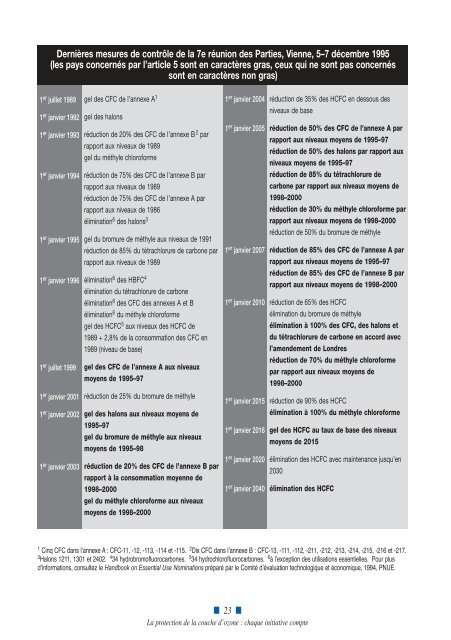La protection de la couche d'ozone : chaque initiative compte
La protection de la couche d'ozone : chaque initiative compte
La protection de la couche d'ozone : chaque initiative compte
Create successful ePaper yourself
Turn your PDF publications into a flip-book with our unique Google optimized e-Paper software.
Dernières mesures <strong>de</strong> contrôle <strong>de</strong> <strong>la</strong> 7e réunion <strong>de</strong>s Parties, Vienne, 5–7 décembre 1995<br />
(les pays concernés par l’article 5 sont en caractères gras, ceux qui ne sont pas concernés<br />
sont en caractères non gras)<br />
1 er juillet 1989<br />
1 er janvier 1992 gel <strong>de</strong>s halons<br />
1 er janvier 1993<br />
1 er janvier 1994<br />
1 er janvier 1995<br />
1 er janvier 1996<br />
1 er juillet 1999<br />
1 er janvier 2001 réduction <strong>de</strong> 25% du bromure <strong>de</strong> méthyle<br />
1 er janvier 2002<br />
1 er janvier 2003<br />
gel <strong>de</strong>s CFC <strong>de</strong> l’annexe A 1<br />
réduction <strong>de</strong> 20% <strong>de</strong>s CFC <strong>de</strong> l’annexe B 2 par<br />
rapport aux niveaux <strong>de</strong> 1989<br />
gel du méthyle chloroforme<br />
réduction <strong>de</strong> 75% <strong>de</strong>s CFC <strong>de</strong> l’annexe B par<br />
rapport aux niveaux <strong>de</strong> 1989<br />
réduction <strong>de</strong> 75% <strong>de</strong>s CFC <strong>de</strong> l’annexe A par<br />
rapport aux niveaux <strong>de</strong> 1986<br />
élimination 6 <strong>de</strong>s halons 3<br />
gel du bromure <strong>de</strong> méthyle aux niveaux <strong>de</strong> 1991<br />
réduction <strong>de</strong> 85% du tétrachlorure <strong>de</strong> carbone par<br />
rapport aux niveaux <strong>de</strong> 1989<br />
élimination 6 <strong>de</strong>s HBFC 4<br />
élimination du tétrachlorure <strong>de</strong> carbone<br />
élimination 6 <strong>de</strong>s CFC <strong>de</strong>s annexes A et B<br />
élimination 6 du méthyle chloroforme<br />
gel <strong>de</strong>s HCFC 5 aux niveaux <strong>de</strong>s HCFC <strong>de</strong><br />
1989 + 2,8% <strong>de</strong> <strong>la</strong> consommation <strong>de</strong>s CFC en<br />
1989 (niveau <strong>de</strong> base)<br />
gel <strong>de</strong>s CFC <strong>de</strong> l’annexe A aux niveaux<br />
moyens <strong>de</strong> 1995–97<br />
gel <strong>de</strong>s halons aux niveaux moyens <strong>de</strong><br />
1995–97<br />
gel du bromure <strong>de</strong> méthyle aux niveaux<br />
moyens <strong>de</strong> 1995–98<br />
réduction <strong>de</strong> 20% <strong>de</strong>s CFC <strong>de</strong> l’annexe B par<br />
rapport à <strong>la</strong> consommation moyenne <strong>de</strong><br />
1998–2000<br />
gel du méthyle chloroforme aux niveaux<br />
moyens <strong>de</strong> 1998–2000<br />
1 er janvier 2004<br />
1 er janvier 2005<br />
1 er janvier 2007<br />
1 er janvier 2010<br />
1 er janvier 2015<br />
1 er janvier 2016<br />
1 er janvier 2020<br />
réduction <strong>de</strong> 35% <strong>de</strong>s HCFC en <strong>de</strong>ssous <strong>de</strong>s<br />
niveaux <strong>de</strong> base<br />
réduction <strong>de</strong> 50% <strong>de</strong>s CFC <strong>de</strong> l’annexe A par<br />
rapport aux niveaux moyens <strong>de</strong> 1995–97<br />
réduction <strong>de</strong> 50% <strong>de</strong>s halons par rapport aux<br />
niveaux moyens <strong>de</strong> 1995–97<br />
réduction <strong>de</strong> 85% du tétrachlorure <strong>de</strong><br />
carbone par rapport aux niveaux moyens <strong>de</strong><br />
1998–2000<br />
réduction <strong>de</strong> 30% du méthyle chloroforme par<br />
rapport aux niveaux moyens <strong>de</strong> 1998–2000<br />
réduction <strong>de</strong> 50% du bromure <strong>de</strong> méthyle<br />
réduction <strong>de</strong> 85% <strong>de</strong>s CFC <strong>de</strong> l’annexe A par<br />
rapport aux niveaux moyens <strong>de</strong> 1995–97<br />
réduction <strong>de</strong> 85% <strong>de</strong>s CFC <strong>de</strong> l’annexe B par<br />
rapport aux niveaux moyens <strong>de</strong> 1998–2000<br />
réduction <strong>de</strong> 65% <strong>de</strong>s HCFC<br />
élimination du bromure <strong>de</strong> méthyle<br />
élimination à 100% <strong>de</strong>s CFC, <strong>de</strong>s halons et<br />
du tétrachlorure <strong>de</strong> carbone en accord avec<br />
l’amen<strong>de</strong>ment <strong>de</strong> Londres<br />
réduction <strong>de</strong> 70% du méthyle chloroforme<br />
par rapport aux niveaux moyens <strong>de</strong><br />
1998–2000<br />
réduction <strong>de</strong> 90% <strong>de</strong>s HCFC<br />
élimination à 100% du méthyle chloroforme<br />
gel <strong>de</strong>s HCFC au taux <strong>de</strong> base <strong>de</strong>s niveaux<br />
moyens <strong>de</strong> 2015<br />
élimination <strong>de</strong>s HCFC avec maintenance jusqu’en<br />
2030<br />
1 er janvier 2040 élimination <strong>de</strong>s HCFC<br />
1 Cinq CFC dans l’annexe A : CFC-11, -12, -113, -114 et -115. 2 Dix CFC dans l’annexe B : CFC-13, -111, -112, -211, -212, -213, -214, -215, -216 et -217.<br />
3 Halons 1211, 1301 et 2402. 4 34 hydrobromofluorocarbones. 5 34 hydrochlorofluorocarbones. 6 à l’exception <strong>de</strong>s utilisations essentielles. Pour plus<br />
d’informations, consultez le Handbook on Essential Use Nominations préparé par le Comité d’évaluation technologique et économique, 1994, PNUE.<br />
■ 23 ■<br />
<strong>La</strong> <strong>protection</strong> <strong>de</strong> <strong>la</strong> <strong>couche</strong> d’ozone : <strong>chaque</strong> <strong>initiative</strong> <strong>compte</strong>
















